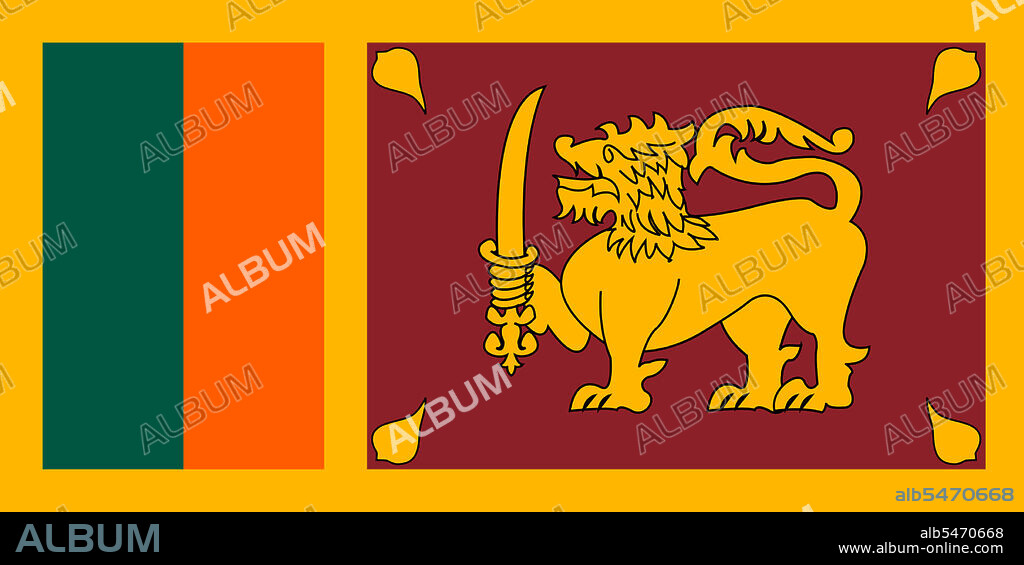alb5470668
Flag of Sri Lanka,1972-present day.

|
Add to another lightbox |
|
Add to another lightbox |



Buy this image.
Select the use:

Title:
Flag of Sri Lanka,1972-present day.
Caption:
The Flag of Sri Lanka, also called the Lion Flag, consists of a gold lion, holding a sword in its right fore paw, in front of a crimson background with four golden bo leaves in each corner. Around the background is a yellow border, and to its left are two vertical stripes of equal size in saffron and green, with the saffron stripe closest to the lion. The lion represents bravery, and the four bo leaves represent meththa, karuna, muditha and upeksha. The orange stripe represents the Sri Lankan Tamils, the green stripe represents Sri Lankan Moors, the crimson background represents European Burghers and is also a reference to the rich colonial background of the country and the yellow border represents other ethnic groups such as Sri Lankan Malays etc. Sri Lanka had always been an important port and trading post in the ancient world, and was increasingly frequented by merchant ships from the Middle East, Persia, Burma, Thailand, Malaysia, Indonesia and other parts of Southeast Asia. The islands were known to the first European explorers of South Asia and settled by many groups of Arab and Malay merchants. A Portuguese colonial mission arrived on the island in 1505 headed by Lourenco de Almeida, the son of Francisco de Almeida. At that point the island consisted of three kingdoms, namely Kandy in the central hills, Kotte at the Western coast, and Yarlpanam (Anglicised Jaffna) in the north. The Dutch arrived in the 17th century. The British East India Company took over the coastal regions controlled by the Dutch in 1796, and in 1802 these provinces were declared a crown colony under direct rule of the British government, therefore the island was not part of the British Raj. The annexation of the Kingdom of Kandy in 1815 by the Kandyan convention, unified the island under British rule. European colonists established a series of cinnamon, sugar, coffee, indigo cultivation followed by tea and rubber plantations and graphite mining. The British also brought a large number of indentured workers from Tamil Nadu to work in the plantation economy. The city of Colombo was developed as the administrative centre and commercial heart with its harbor, and the British established modern schools, colleges, roads and churches that introduced Western-style education and culture to the Ceylonese. On 4 February 1948 the country gained its independence as the Dominion of Ceylon. It changed its name to Sri Lanka in 1972.
Credit:
Album / Pictures From History/Universal Images Group
Releases:
Image size:
5910 x 2955 px | 50.0 MB
Print size:
50.0 x 25.0 cm | 19.7 x 9.8 in (300 dpi)
Keywords:
ANIMAL: LION • ASIA • ASIAN • BANNER • CEYLON • CEYLONESE • DOMINION • FLAG • FLAGS • HISTORIA UNIVERSAL • HISTORIA • HISTORICAL • HISTORY • HISTORY. • INDEPENDENCE • LEO • LEON • LION • LIONS • MYTHICAL LION • SINGHA • SRI LANKA • SRI LANKAN


 Pinterest
Pinterest Twitter
Twitter Facebook
Facebook Copy link
Copy link Email
Email
